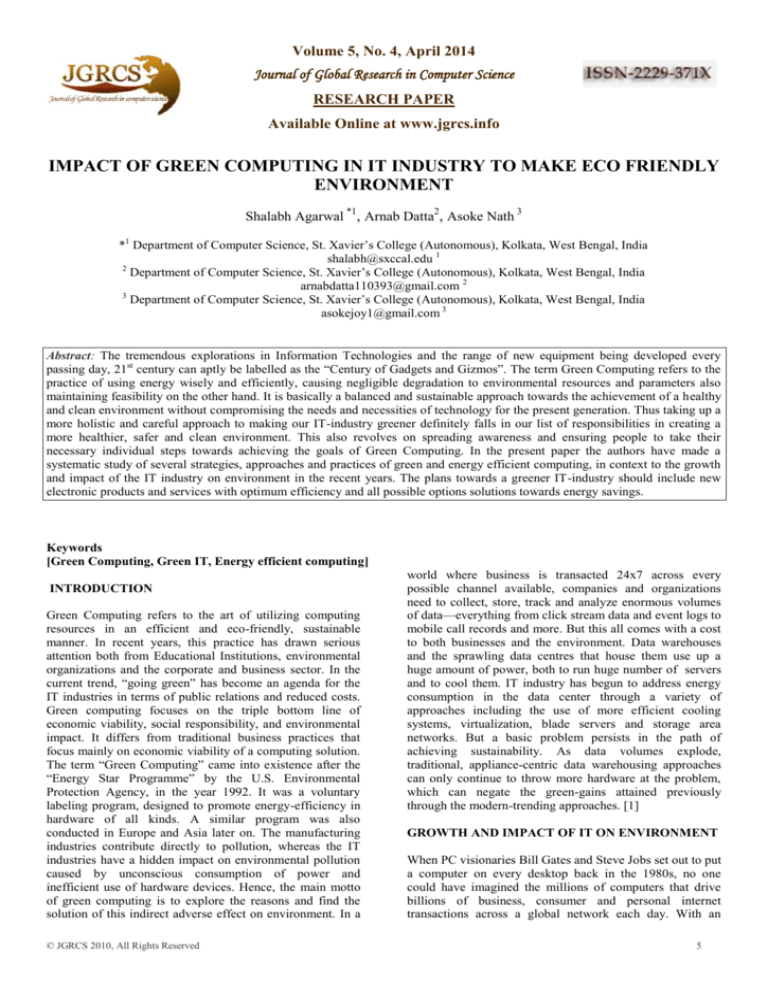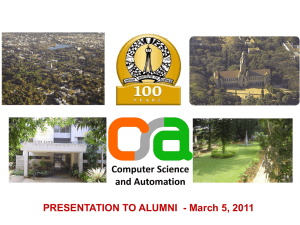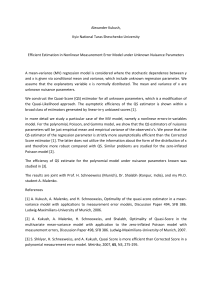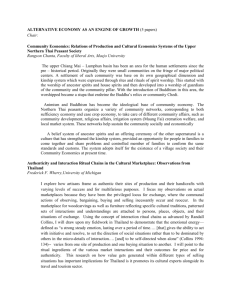
Volume 5, No. 4, April 2014
Journal of Global Research in Computer Science
RESEARCH PAPER
Available Online at www.jgrcs.info
IMPACT OF GREEN COMPUTING IN IT INDUSTRY TO MAKE ECO FRIENDLY
ENVIRONMENT
Shalabh Agarwal *1, Arnab Datta2, Asoke Nath 3
*1 Department of Computer Science, St. Xavier’s College (Autonomous), Kolkata, West Bengal, India
shalabh@sxccal.edu 1
2
Department of Computer Science, St. Xavier’s College (Autonomous), Kolkata, West Bengal, India
arnabdatta110393@gmail.com 2
3
Department of Computer Science, St. Xavier’s College (Autonomous), Kolkata, West Bengal, India
asokejoy1@gmail.com 3
Abstract: The tremendous explorations in Information Technologies and the range of new equipment being developed every
passing day, 21st century can aptly be labelled as the ―Century of Gadgets and Gizmos‖. The term Green Computing refers to the
practice of using energy wisely and efficiently, causing negligible degradation to environmental resources and parameters also
maintaining feasibility on the other hand. It is basically a balanced and sustainable approach towards the achievement of a healthy
and clean environment without compromising the needs and necessities of technology for the present generation. Thus taking up a
more holistic and careful approach to making our IT-industry greener definitely falls in our list of responsibilities in creating a
more healthier, safer and clean environment. This also revolves on spreading awareness and ensuring people to take their
necessary individual steps towards achieving the goals of Green Computing. In the present paper the authors have made a
systematic study of several strategies, approaches and practices of green and energy efficient computing, in context to the growth
and impact of the IT industry on environment in the recent years. The plans towards a greener IT-industry should include new
electronic products and services with optimum efficiency and all possible options solutions towards energy savings.
Keywords
[Green Computing, Green IT, Energy efficient computing]
INTRODUCTION
Green Computing refers to the art of utilizing computing
resources in an efficient and eco-friendly, sustainable
manner. In recent years, this practice has drawn serious
attention both from Educational Institutions, environmental
organizations and the corporate and business sector. In the
current trend, ―going green‖ has become an agenda for the
IT industries in terms of public relations and reduced costs.
Green computing focuses on the triple bottom line of
economic viability, social responsibility, and environmental
impact. It differs from traditional business practices that
focus mainly on economic viability of a computing solution.
The term ―Green Computing‖ came into existence after the
―Energy Star Programme‖ by the U.S. Environmental
Protection Agency, in the year 1992. It was a voluntary
labeling program, designed to promote energy-efficiency in
hardware of all kinds. A similar program was also
conducted in Europe and Asia later on. The manufacturing
industries contribute directly to pollution, whereas the IT
industries have a hidden impact on environmental pollution
caused by unconscious consumption of power and
inefficient use of hardware devices. Hence, the main motto
of green computing is to explore the reasons and find the
solution of this indirect adverse effect on environment. In a
© JGRCS 2010, All Rights Reserved
world where business is transacted 24x7 across every
possible channel available, companies and organizations
need to collect, store, track and analyze enormous volumes
of data—everything from click stream data and event logs to
mobile call records and more. But this all comes with a cost
to both businesses and the environment. Data warehouses
and the sprawling data centres that house them use up a
huge amount of power, both to run huge number of servers
and to cool them. IT industry has begun to address energy
consumption in the data center through a variety of
approaches including the use of more efficient cooling
systems, virtualization, blade servers and storage area
networks. But a basic problem persists in the path of
achieving sustainability. As data volumes explode,
traditional, appliance-centric data warehousing approaches
can only continue to throw more hardware at the problem,
which can negate the green-gains attained previously
through the modern-trending approaches. [1]
GROWTH AND IMPACT OF IT ON ENVIRONMENT
When PC visionaries Bill Gates and Steve Jobs set out to put
a computer on every desktop back in the 1980s, no one
could have imagined the millions of computers that drive
billions of business, consumer and personal internet
transactions across a global network each day. With an
5
Shalabh Agarwal et al, Journal of Global Research in Computer Science, 5 (4), April 2014, 5-9
average desktop computer and monitor consuming between
60 and 300 watts of electricity, it is not surprising that
energy consumption and cost reduction programs represent a
major area of focus and opportunity within Green IT. [2]
A business with a network of 20,000 desktop systems
running 24 x 7 drawing 200 Watts consumes about 35
million kWh of electricity annually. Using the average U.S.
cost of electricity at $.0855/kWh, this would cost this
business approximately $3 million in utility charges
annually. An estimated 90% of workstations in use on any
given normal working day have their energy conservation
features disabled. On a base of 20,000 workstations,
implementing power management policies and standards
would represent an annual savings of between $900,000 on
the lower-end 60 watt devices and up to $2.4 million on a
base of higher-end devices annually. [2]
To a small business or homeowner looking at energy costs,
these numbers are not large, nor are they the kinds of
numbers that tend to stimulate immediate action. It is
perhaps for this reason we find that business and
homeowners give little thought to leaving their desktop PCs
powered up with their screensavers running 24 hours-a day.
The cumulative impact, however, when looked at from the
perspective of the electrical drain created by a medium-sized
business or community presents an entirely different picture.
[2]
Fig.1: Graphical representation of statistical data of Initiatives by people to reduce power consumption [4]
GREEN COMPUTING SOLUTIONS
Develop sustainable green-computing plans
This involves active participation of all the people
associated with the industries from the topmost
levels to the lowermost rungs. Organizational
policies and checklists needs to be prepared,
containing mandatory guidelines, government
policies,
―green-recommendations‖,
list
of
recyclable and non-recyclable items. The best
practices and strategies should aim at reduction of
usage of non-conventional resources, by reducing
usage of paper and recycling of old machineries
and systems in order to nullify e-wastes from
organizations.
Recycle and Reuse
Discard used or unwanted electronic equipment in
a convenient and environmentally responsible
manner. Computers have toxin metals and
pollutants that can emit harmful emissions into the
environment. Never discard computers in a landfill.
Recycle them instead through manufacturer
programs such as recycling facilities in your
community. Or donate still-working computers to a
non-profit agency. [3]
Purchase products which are environmentally
green and sound
Purchase products which are labeled to be green
and safe for you as well as the environment. These
products help to reduce the degradation caused by
© JGRCS 2010, All Rights Reserved
the energy-consumption to the environment. For
these consumers should be encouraged to buy
environmentally sound products. Clear and
flawless criteria must be set for the design of greenproducts. Manufacturers too must be involved and
given proper credits for the process of
manufacturing products which are healthier for the
environment.
Purchase
Electronic
Product
Environmental Assessment Tool registered
products. EPEAT is a procurement tool promoted
by the nonprofit Green Electronics Council. [3]
Minimizing consumption of paper
There are many ways of nullifying the consumption
of paper. With computers being more popular than
any other thing today all jobs can be done on the
accumulator.
Sophisticated
modes
of
communications like e-mail, free-messaging, other
social
networking
sites
have
brought
communication to your doorstep. Moreover paper
is also being saved by the industries, as more and
more industries are trying to convert themselves to
―paper-less-mode‖ with each passing day.
Conservation of energy
All
electronic
gadgets
demonstrate
the
consumption of energy which has been extracted
from non-renewable energy resources. So adopt the
proper tactics and techniques so as to conserve
energy so that it can be used in times of actual
need.
Green Procurement and Asset Management
6
Shalabh Agarwal et al, Journal of Global Research in Computer Science, 5 (4), April 2014, 5-9
Don’t run computers continuously unless they are
in use continuously.
Look for ways to reduce the amount of time your
computer is on without adversely affecting your
productivity.
Unless you require immediate access to E-mail or
other Internet services, break the habit of turning
on all your computer equipment as soon as you
enter the office each day.
If practical, informally group your computer
activities and try to do then during one or two parts
of the day leaving the computers off at other times.
Avoid using the switch on a power strip to turn on
all your equipment.
If you use a laser printer, don’t turn your printer on
until you are ready to print.
Turn off your entire computer system or at least
your monitor and printer when you go for lunch or
will be out of office for a meeting or an errand.
For ―computer servers‖ which must be on to serve
network functions, explore ways to turn servers off
at night.
If monitors are not needed for ―servers‖ to operate,
keep server monitors off. If server monitor is
needed during the day, at least turn off at night and
weekends.
This category includes initiatives that focus on
purchasing computing equipment that is more
energy efficient and environmentally friendly and
includes programs to extend equipment useful life,
recycle and engage with suppliers that demonstrate
a commitment to reducing hazardous materials in
their manufacturing, packaging and factory waste
management programs.[2]
Technology-based solutions
This category includes programs that employ
technology in ways that are designed to reduce
travel, commuting and real estate costs along with
the environmental impacts of jobs related to people
movement. [2]
ENERGY EFFICIENT COMPUTING PRACTICES
Energy efficient computing is the practice of using
computing devices, with concerns for energy saving and
productive utilization. Some such computing methodologies
are:
Turn off your computer and/or peripheral when
they are not in use. Turning on and off will not
harm the equipment.
Fig.2: Graphical representation of statistical data of the awareness in people and motivating factors [4]
Some other green computing practices include:
Reducing Paper Waste
Reusing and Recycling of Hardware Devices
Purchasing Recommendations
Reducing Paper Waste:
Computer use has vastly increased paper consumption and
per waste. Here are some suggestions for reducing waste:
Print as little as possible. Review and modify
documents on the screen and use print preview.
Minimize the number of hard copies and paper
drafts you make. Instead of printing, save
information to disks.
Recycle waste paper as many times as you can.
Save e-mail whenever possible and avoid needless
printing of E-mail messages.
© JGRCS 2010, All Rights Reserved
Use e-mail instead of faxes or send faxes directly
from your computer to eliminate the need for a
hard copy.
On larger documents, use smaller font sizes to save
paper.
When documents are printed or copies use double
sided printing and copying. If possible, use the
multiple pages per sheet option on printer
properties.
When general information-type documents must be
shared within an office, try circulating them instead
of making an individual copy for each person. This
can also be done easily by e-mail.
Reusing and Recycling of Hardware Devices: This is one
of the most important aspects of Green Computing that
7
Shalabh Agarwal et al, Journal of Global Research in Computer Science, 5 (4), April 2014, 5-9
revolves around e-waste management. It involves making
unused and old hardware devices or computing resources
reusable through the process of recycling, for example,
inkjet cartridges, batteries and diskettes can be recycled for
further use.
Purchasing
Recommendations:
Environmentally
responsible computer use implies not buying new equipment
unless there is a demonstrated need. Here are some
recommendations:
Buy only ―Energy Star‖ computers, monitors and
printers. Flat panel monitors use about half of the
electricity of a CRT (Cathode-Ray-Tube) display.
Buy a monitor only as larger as you really need. A
17-inch CRT monitor uses 30% more energy than a
15-inch one when each is in an active mode.
Buy inkjet printers, not Laser printers. These use
80%-90% less energy than laser printers and print
quality can be excellent.
Consider buying ―Green Computers‖, once they are
available in market.
Buy non-petroleum based ink. These printer inks
are made from renewable resources, require fewer
hazardous solvents, which translate to fewer air
emissions, and in many cases produce brighter,
cleaner colors.
Fig.3: Graphical representation of statistical data of awareness and activeness in people to take steps towards Green IT [4]
FUTURE OF GREEN COMPUTING
The plan towards green IT should include new electronic
products and services with optimum efficiency and all
possible options towards energy savings. That is enterprise
wise companies are laying emphasis on moving towards
Eco-Friendly Components in computers, the use of ecofriendly sustainable components will become the norm
rather than the exception in future. To this approach for
an instance - A Canadian
Company, Userful Inc. have come up with a solution that
turns 1 computer into 10 - Discover Station. Quickly
becoming the standard for green computing worldwide,
Discover Station leverages the unused computing power of
modern PC’s to create an environmentally efficient
alternative to traditional desktop computing. Multiple users
can work on a single computer by simply. [5]
It is estimated that out of $250 billion per year spent on
powering computers worldwide only about 15% of that
power is spent computing- the rest is wasted idling. Thus,
energy saved on computer hardware and computing will
equate tonnes of carbon emissions saved per year. Taking
into consideration the popular use of information technology
industry, it has to lead a revolution of sorts by turning green
in a manner no industry has ever done before. Opportunities
lie in green technology like never before in history and
organizations are seeing it as a way to create new profit
centres while trying to help the environmental cause.[1] The
© JGRCS 2010, All Rights Reserved
plan towards green IT should include new electronic
products and services with optimum efficiency and all
possible options towards energy savings. Faster processors
historically use more power. Inefficient CPU's are a double
hit because they both use too much power themselves and
their waste heat increases air conditioning needs, especially
in server farms--between the computers and the HVAC. The
waste heat also causes reliability problems, as CPU's crash
much more often at high temperatures. Many people have
been working for years to lice this inefficiency out of
computers. Similarly, power supplies are notoriously bad,
generally as little as 7% efficient. And since everything in a
computer runs off the power supply, nothing can be efficient
without a good power supply. Recent inventions of power
supply are helping fix this by running at 80% efficiency or
better. [6]
CONCLUSION
It is clear that the mushrooming growth of IT industries
worldwide is slowly poisoning the environment. This grave
threat requires immediate attention. Societies need to
become more energy conscious. The need of the hour is for
both governments and the corporate world to join hands to
usher in more green computing solutions to be able to build
a green-globe.
8
Shalabh Agarwal et al, Journal of Global Research in Computer Science, 5 (4), April 2014, 5-9
Green computing is a mindset that asks how we can satisfy
the growing demand for network computing without putting
such pressure on the environment. There is an alternative
way to design a processor and a system such that we don't
increase demands on the environment, but still provide an
increased amount of processing capability to customers to
satisfy their business needs. Green computing is not about
going out and designing biodegradable packaging for
products. Now the time has come to think about the
efficiently use of computers and the resources which are
non-renewable. It opens a new window for the new
entrepreneur for harvesting with E-waste material and scrap
computers. The greenest computer will not miraculously fall
from the sky one day; it’ll be the product of years of
improvements. The features of a green computer of
tomorrow would be like: efficiency, manufacturing &
materials, recyclability, service model, self-powering, and
other trends. Green computer will be one of the major
contributions which will break down the 'digital divide', the
electronic gulf that separates the information rich from the
information poor. [5]
ACKNOWLEDGMENT
We are very much grateful to UGC for the MRP which has
enabled us to carry out the research. We are also obliged St.
Xavier's College to give us opportunity to carry out our
research. We are also grateful to our fellow professors and
colleagues for their support and constant encouragement
References
[1]
[2]
[3]
[4]
[5]
[6]
[7]
Green Computing Endeavor in Higher Educational Institutes –
a noble initiative towards Sustainable IT Infrastructure,
Shalabh Agarwal, Archana Vimal, Saima Ghosh, Asoke Nath,
Journal of Computing(USA), Vol 4, issues 5, May, ISSN9617, Page-217-222, 2012
―Green Computing - a new Horizon of Energy Efficiency and
Electronic waste minimization‖: a Global Perspective,
Shalabh Agarwal and Asoke Nath : Proceedings of IEEE
CSNT-2011 held at SMVDU(Jammu) 03-06 June 2011, Page
688-693(2011).
Desktop Virtualization and Green Computing Solutions,
Shalabh Agarwal and Asoke Nath, The Second International
Conference on "Soft Computing for Problem Solving
(SocProS 2012)" published in the proceedings of the
conference SocPros 2012 held in December 28 - 30, 2012 and
will be published in Conference proceedings in AISC series of
Springer.
A Study on implementing Green IT in Enterprise 2.0, Shalabh
Agarwal, Asoke Nath, International Journal of Advanced
Computer Research, Vol-3, No.1, Issue-3(march),pp. 4349(2013).
A Comprehensive study on Cloud Green Computing : To
Reduce Carbon Footprints Using Clouds,Chiranjeeb Roy
Chowdhury, Arindam Chatterjee, Alap Sardar, Shalabh
Agarwal, Asoke Nath, International Journal of Advanced
Computer Research, Vol-3, No.1, Issue-3(march),pp. 7885(2013).
Application of Green computing in Framing Energy Efficient
Software Engineering, Aritra Mitra, Riya Basu, Avik Guha,
Shalabh Agarwal,Asoke Nath, International Journal of
Advanced Computer Research, Vol-3, No.1, Issue3(march),pp. 117-121(2013).
Green Software Engineering Process : Moving Towards
Sustainable Software Product Design, Shantanu Ray, Nabaraj
Sengupta, Koustav Maitra, Kaushik Goswami, Shalabh
Agarwal, Asoke Nath, Journal of Global Research in
Computer Science(ISSN-2229- 371X), Vol-4, No.1, pp.2529(2013).
© JGRCS 2010, All Rights Reserved
[8]
[9]
[10]
[11]
[12]
[13]
Green Computing and Green Technology in e-Learning,
Corporate, Business and IT Sectors, Shalabh Agarwal, Shreya
Goswami, Asoke Nath, International Journal of Computer
Applications(IJCA), Vol 76, No.7, (August), Pp. 35-41(2013).
Green Computing and Green Technology based teaching
learning and administration in Higher Education Institutions:
Shalabh Agarwal, Kaustuvi Basu, Asoke Nath Asoke Nath,
Bidhusundar Samanta, International Journal of Advanced
Computer Research, Vol-2, Number-3, issue-11, Sept, pp 295303(2013).
"Thin Clients 2011 - Ecological and economical aspects of
virtual desktops", a study conducted by Fraunhofer Institute of
Environmental, Safety and Energy Technology UMSICHT
―Green Computing - a new Horizon of Energy Efficiency
and Electronic waste minimization‖: a Global Perspective,
Shalabh Agarwal and Asoke Nath : Proceedings of IEEE
CSNT-2011 held at SMVDU(Jammu) 03-06 June 2011, Page
688-693.
Cloud Computing is an application of Green Computing – a
new horizon of Energy Efficiency and its beyond—Shalabh
Agarwal, Asoke Nath proceedings of International
conference ICCA 2012 held at Pondechery Jan 27-31, 2012.
"Thin Clients 2011 - Ecological and economical aspects of
virtual desktops", a study conducted by Fraunhofer Institute of
Environmental, Safety and Energy Technology UMSICHT
[14] Green Computing is SMART COMPUTING – A
Survey, Ms Swati Aggarwal, Mrs. Monika Garg, Mr.
Pramod Kumar, International Journal of Engineering,
Vol. 2, Issue 2, Feb 2012.
[15] A Study on Green Computing: The Future Computing
and Eco-Friendly Technology, by S.V.S.S. Lakshmi,
Ms. I Sri Lalita Sarwani, M.Nalini Tuveera /
International Journal of Engineering Research and
Applications (IJERA) Vol. 2, Issue4, July-August
2012.
SHORT BIODATA OF ALL THE AUTHORS
Prof. Shalabh Agarwal is Associate Professor and
HOD of Department of Computer Science, St. Xavier’s College
(Autonomous), Kolkata. Keeping up with the latest trends, he is
very keen on research and has many publications in International
and National journals, including a few in IEEE sponsored
conferences and journals. His main area of research is Green
Computing, Sustainable IT infrastructure and Cyber Law
Arnab Datta is a final year student of B.Sc. Computer
Science (Hons.), at St. Xavier’s College (Autonomous), Kolkata.
He has immense interest in research, and has contributed
considerably in research endeavours.
Dr. Asoke Nath is Associate Professor in
Department of Computer Science, St. Xavier’s College
(Autonomous), Kolkata. His major research areas are
9
Shalabh Agarwal et al, Journal of Global Research in Computer Science, 5 (4), April 2014, 5-9
Cryptography and Network Security, Data Hiding, Image
Processing, Green Computing, e-learning .
© JGRCS 2010, All Rights Reserved
10







